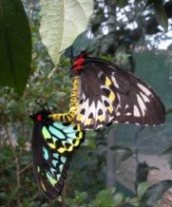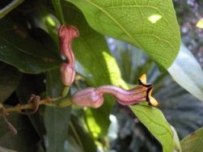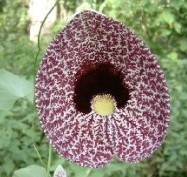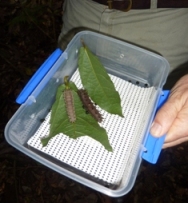Richmond birdwing butterfly

Common name: Richmond birdwing butterfly
Scientific name: Ornithoptera richmondia
Family: Papilionidae (swallowtails)
Status: Vulnerable
The spectacular Richmond birdwing butterfly is one of Australia’s largest butterflies with a wingspan of up to 16cm. Females have dark brown or black wings with extensive white, cream or, in the hindwing, yellowish markings. Males have a black upper forewing with a distinctive iridescent green leading edge. The upper hindwing is predominantly iridescent green with black spots.
The butterfly is classed as vulnerable and mainly lives in subtropical rainforest which support native birdwing butterfly vines (Pararistolochia praevenosa), its sole food resource.It can be found in two main areas:
- from Caboolture, north of Brisbane, to Cootharaba on the Sunshine Coast
- from Wardell, in north-east New South Wales, to Ormeau and Mount Tamborine in the Gold Coast hinterland.
The Richmond birdwing occasionally occurs in the greater Brisbane area but there are no known breeding populations in the area.


Threats and recovery actions
The native birdwing butterfly vine is patchily distributed and in low abundance in its natural habitat. It is classed as near threatened in Queensland.
Habitat loss and fragmentation have caused the butterfly’s distribution to shrink. As the remaining sub-populations become isolated, the resulting inbreeding can lead to a range of detrimental effects, even causing local extinctions. The impacts of habitat loss, fragmentation and inbreeding are exacerbated by climate change, which increases the severity and frequency of drought events. A lack of rainfall prevents the production of soft new leaves on the birdwing butterfly vines, which the young larvae require for their early development.
The butterfly is also attracted to lay on the introduced Dutchman’s pipe (Aristolochia elegans)which is a common introduced plant in many gardens and some areas of bushland. However, the leaves of this invasive vine are toxic and kill the larvae when eaten.

Since 2008, the Queensland Government has partnered with the Richmond Birdwing Conservation Network, which operates under the umbrella of the Wildlife Preservation Society of Queensland, to run a captive-breeding and release program. Butterflies from different locations are mated to produce more genetically diverse offspring. The offspring are introduced at selected sites to help restore wild populations. Around 500 individuals, mostly larvae and pupae, have been distributed to 11 sites across South East Queensland. This has resulted in natural breeding at the release sites, bolstering local sub-population sizes and resulting in more adult butterflies being spotted in the wild.
Along with the Richmond Birdwing Conservation Network, local governments, Seqwater, conservation organisations, community groups and the public are helping conserve the butterfly. These conservation efforts include:
- reinstating the birdwing butterfly vine to link existing remnant habitat and isolated butterfly populations
- removing Dutchman’s pipe
- reporting occurrences of the butterfly and vines to enable their distribution to be mapped.
For more information about the Richmond birdwing butterfly, view the species profile.
Learn more about how you can help the Richmond birdwing butterfly and other Australian wildlife by supporting threatened species projects and caring for our native plants and animals.


